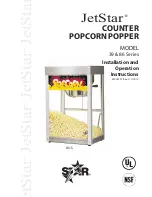
7. CLEANING
20
CITIZEN EP70
7. CLEANING
At the end of each working day (or more frequently if possible) it is
necessary to carefully clean the cooking surface and all the parts of the
oven which come into contact with the food being cooked to avoid that any
food substances go off and contaminate either the working environment or
later products to be cooked.
Cleaning should be carried out with the equipment switched off and
at room temperature and after having switched off its electrical supply
using the button on the feed panel.
7.1
Cleaning of any visible glass and stainless steel parts
Glass is particularly sensitive to sudden changes in temperature
which can cause it to shatter into fragments.
Do not handle the glass or
bring it into contact with water until it is at room temperature.
It is also not advisable to use abrasives (abrasive sponges and such
like) as they may in the long term diminish the shine of stainless steel parts
and of glass. It is better to wash the various removable parts before the
food residues are dry.
7.2
Cleaning of any refractory parts
Use a brush to remove cooking residues from the refractory surfaces in
the ovens. If there are any residues stuck to the refractory surfaces,
remove them carefully with a spatula.
Do not use any liquids, especially detergents, since the refractory
material is porous and it is not possible to rinse it to ensure it is not
contaminated by foods in contact with these surfaces.
You should also not use cleaning instruments which are too abrasive
as the refractory material is fragile and could easily get chipped or even
break.
7.3
Cleaning the oven’s baking chamber
Use a soft damp sponge to clean the stainless steel or aluminium plate
baking chamber, if necessary with a light, non abrasive detergent, being
careful that it does not splash onto any refractory surfaces.
















































